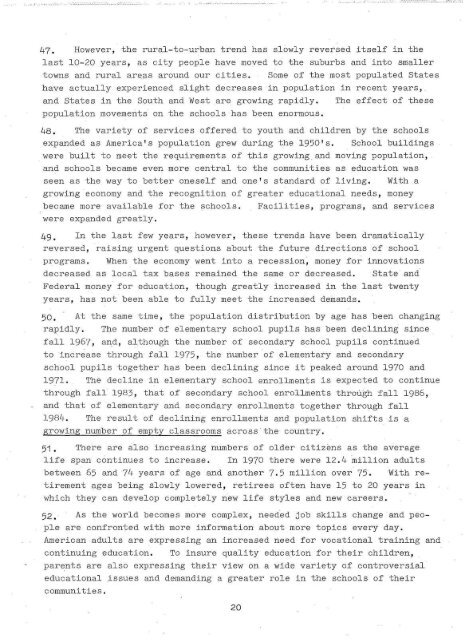BUILDING FOR SCHOOL AND COMMUNITY - Kennedy Bibliothek
BUILDING FOR SCHOOL AND COMMUNITY - Kennedy Bibliothek
BUILDING FOR SCHOOL AND COMMUNITY - Kennedy Bibliothek
Create successful ePaper yourself
Turn your PDF publications into a flip-book with our unique Google optimized e-Paper software.
47. However, the rural-to-urban trend has slowly reversed itself in the<br />
last 10-20 years, as city people have moved to the suburbs and into smaller<br />
towns and rural areas around our cities. Some of the most populated States<br />
have actually experienced slight decreases in population in recent years,,<br />
and States in the South and West are growing rapidly. The effect of these<br />
population movements on the schools has been enormous.<br />
48. The variety of services offered to youth and children by the schools<br />
expanded as America's population grew during the 1950's. School buildings<br />
were built to meet the requirements of this growing and moving population,<br />
and schools became even more central to the communities as education was<br />
seen as the way to better oneself and one's standard of living. With a<br />
growing economy and the recognition of greater educational needs, money<br />
became more available for the schools. Facilities, programs, and services<br />
were expanded greatly.<br />
4g# In the last few years, however, these trends have been dramatically<br />
reversed, raising urgent questions about the future directions of school<br />
programs. When the economy went into a recession, money for innovations<br />
decreased as local tax bases remained the same or decreased. State and<br />
Federal money for education, though greatly increased in the last twenty<br />
years, has not been able to fully meet the increased demands.<br />
50. At the same time, the population distribution by age has been changing<br />
rapidly. The number of elementary school pupils has been declining since<br />
fall 1967, and, although the number of secondary school pupils continued<br />
to increase through fall 1975, the number of elementary and secondary<br />
school pupils together has been declining since it peaked around 1970 and<br />
1971. The decline in elementary school enrollments is expected to continue<br />
through fall 1983, that of secondary school enrollments through fall 1986,<br />
and that of elementary and secondary enrollments together through fall<br />
1984. The result of declining enrollments and population shifts is a<br />
growing number of empty classrooms across'the country.<br />
51 . There are also increasing numbers of older citizens as the average<br />
life span continues to increase. In 1970 there were 12.4 million adults<br />
between 65 and 74 years of age and another 7.5 million over 75. With retirement<br />
ages being slowly lowered, retirees often have 15 to 20 years in<br />
which they can develop completely new life styles and new careers.<br />
52.• As the world becomes more complex, needed job skills change and people<br />
are confronted with more information about more topics every day.<br />
American adults are expressing an increased need for vocational training and<br />
continuing education. To insure quality education for their children,<br />
parents are also expressing their view on a wide variety of controversial<br />
educational issues and demanding a greater role in the schools of their<br />
communities.<br />
20
















